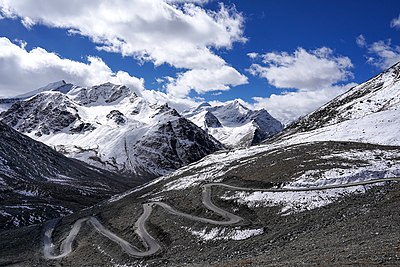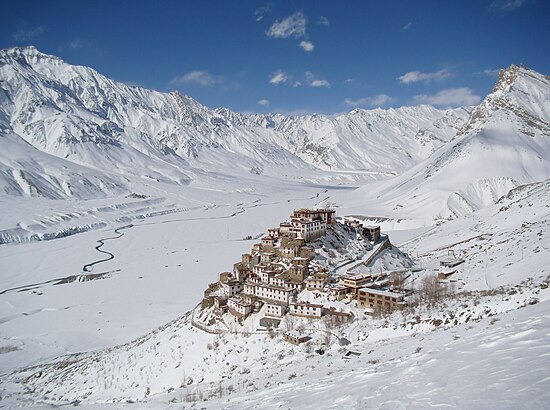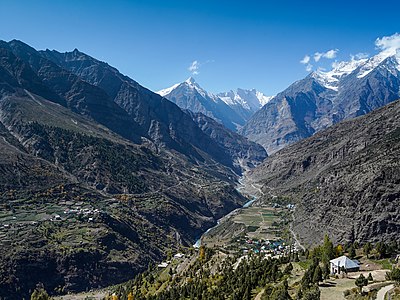User:UnpetitproleX/POTD
Appearance
Shingo La is a high-altitude mountain pass in the Himalayas in northern India, connecting the Lahaul region of Himachal Pradesh with the Zanskar region of Ladakh. The pass is located at an altitude of about 5,000 metres (16,000 ft) and becomes snowbound in the winter months. This photograph, taken in October 2022, depicts the Nimmu–Padum–Darcha road winding through the pass.Photograph credit: Timothy Gonsalves
4 May 2023
The Head of Bhairava is a 16th-century mask from the Kathmandu Valley in Nepal. Made of gilt copper with rock crystal and paint during Nepal's Malla period, it depicts Bhairava, the destructive and terrifying manifestation of the Hindu god Shiva. The mask is in the Metropolitan Museum of Art in New York.Photograph credit: Metropolitan Museum of Art
28 May 2023
Key Monastery is a monastery belonging to the Gelugpa school of Tibetan Buddhism, located at an elevation of 4,166 m (13,668 ft) on a hill rising above the Spiti valley in the northern Indian state of Himachal Pradesh. Said to have been founded in the 11th century, it is the largest monastery in Spiti, housing hundreds of monks. This view shows the monastery in winter, overlooking the snow-covered Spiti river valley with the Himalayas in the background.Photograph credit: Kulbhushan Suryawanshi
4 June 2023
The Palace of Assembly in Chandigarh, India, is a legislative assembly building designed by modernist architect Le Corbusier forming part of the Chandigarh Capitol Complex – a larger government compound including several other buildings such as the Secretariat Building and the Palace of Justice. Constructed to serve as the administrative capital for the eastern half of the historic British Indian Punjab province that remained in India after the 1947 partition of India, the compound, along with sixteen other globally scattered buildings designed by Le Corbusier, was designated a World Heritage Site by UNESCO in 2016. The Palace of Assembly houses the legislatures of the present-day northern Indian states of Punjab and Haryana.Photograph credit: duncid, retouched by UnpetitproleX and Aristeas
14 August 2023
Lahaul and Spiti is a district of the northern Indian state of Himachal Pradesh. Located in the Himalayas, it was formed by the merger of the districts of Lahaul and Spiti in 1960. At the 2011 census of India, it was the least densely populated district of India. This photograph shows the valley of the Bhaga River in Lahaul, with the villages of Kardang (left) and Biling (right) visible on opposite sides of the river, near the district headquarters of Kyelang.Photograph credit: Timothy A. Gonsalves
25 January 2024
Frere Hall is a building in Karachi, Pakistan, built in 1865 to serve as the city's town hall during British colonial rule in the Indian subcontinent. Named in 1884 in honour of Henry Bartle Frere, a British administrator who had earlier served as Commissioner of Sind and Governor of Bombay, the building is now a library and a tourist attraction noted for its Venetian Gothic architecture, and is also used for exhibitions and events.Photographed credit: Alexander Savin
23 March 2024
The City Palace of Jaipur, constructed between 1727 and 1732, is a royal residence located in Jaipur, Rajasthan, India. It was the ceremonial and administrative seat of the Kingdom of Amber, and home of its rulers, from the time of the state's foundation in 1727 by Maharaja Sawai Jai Singh II until 30 March 1949. The palace continues to be a residence of the royal family of Jaipur and is a popular tourist attraction. This picture shows the Leheriya gate, one of four intricately designed gates in an inner courtyard of the palace. The gate is dedicated to Hindu god Ganesha (carved above the door) with the green colour representing the season of spring.Photograph credit: Jakub Hałun
30 March 2024
The mango is an edible stone fruit produced by the tropical tree Mangifera indica. It originated from the region between northwestern Myanmar, Bangladesh, and northeastern India, and is now cultivated across the world, having been introduced to East Africa by Arab and Persian traders in the 9th to 10th centuries and spread further into other areas around the world during the European colonial era. Ripe mangoes vary according to cultivar in size, shape, color, and sweetness. They have a waxy, smooth, and fragrant skin, which is variously yellow, orange, red, or green, and feature a single flat, oblong pit that can be fibrous or hairy on the surface. The fruits may be somewhat round, oval, or kidney-shaped, ranging from 5 to 25 centimetres (2 to 10 inches) in length and from 140 grams (5 ounces) to 2 kilograms (5 pounds) in weight. It is used in culinary products around the world. The mango is the national fruit of India and M. indica is the national tree of Bangladesh. This photograph shows two mangoes grown in Brazil, one whole and one sectioned. The picture was focus-stacked from 12 separate images.Photograph credit: Ivar Leidus
14 August 2024








